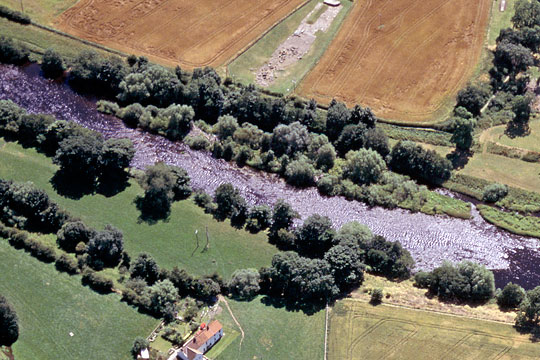Research on Piercebridge Roman Bridge
Few questions remain with respect to the structure of the stone bridge. The wider context of the history of Roman Piercebridge, however, remains far from fully understood.

Research and Excavations
Following the discovery of the bridge remains during gravel quarrying in 1972, the site was excavated by a team of local archaeologists led by Peter Scott, who had also undertaken excavations on parts of the Roman fort and civilian settlement. After Scott’s death in 1987 a summary of his findings about the two bridges was published,[1] and an account of his excavations of Roman Piercebridge in general was published in 2008.[2]
Controversy has surrounded the Piercebridge stone bridge. In the 1980s the late Raymond Selkirk suggested that it was a dam associated with Roman-period management of the Tees and intended to allow its use for navigation.[3] While his ideas initially received much publicity[4] they are not generally accepted; other researchers have demonstrated their impracticality and the lack of genuine evidence to support Selkirk’s suppositions.[5]
Research Gaps
The Bridge
- Our present understanding is that the northern bridge abutment and those piers that were located within the present course of the river have been totally destroyed. New questions might be presented, however, if any evidence is ever found relating to them.
- Pier 5, located under the southern bank of the river, is not fully excavated and might provide additional constructional detail.
- Documentary research might provide greater clarity on the longevity of the bridge as a functioning structure, although Peter Scott did consider this issue.[6]
Roman Piercebridge
- The existence of an early Roman fort somewhere around Piercebridge remains a possibility.
- We do not understand fully the presence of Roman legionary troops in Piercebridge in the early 3rd century, although they may have been associated with the building of the bridge.
- More could be learnt about the 3rd- and 4th-century Roman fort and, in particular, the post-Roman archaeology of Piercebridge. One area of study is the votive finds from the river, which are only now being fully researched.[7]
READ MORE ABOUT PIERCEBRIDGE ROMAN BRIDGE
Footnotes
1. AP Fitzpatrick and PR Scott, ‘The Roman bridge at Piercebridge, North Yorkshire–County Durham’, Britannia, 30 (1999), 111–32 (accessed 7 March 2015; subscription required).
2. HEM Cool and DJP Mason, Roman Piercebridge: Excavations by DW Harding and Peter Scott, 1969–1981, Architectural and Archaeological Society of Durham and Northumberland Report 7 (Durham, 2008). The records of the excavations are available online (accessed 7 Feb 2013).
3. R Selkirk, The Piercebridge Formula (Cambridge, 1983); R Selkirk, ‘A bridge 2 far’, Tyne and Tweed, 44 (1988), 25–34.
4. See for example H Mead, ‘When Romans sailed the Tees?’, Northern Echo, 23 November 1989.
5. TT Hay, ‘Engineering aspects of Piercebridge Roman bridges’, Durham Archaeological Journal, 8 (1992), 63–70.
6. P Scott, ‘The bridges at Piercebridge, co Durham; a reassessment’, Transactions of the Architectural and Archaeological Society of Durham and Northumberland, new series, 6 (1982), 77–82.
7. P Walton, ‘The finds from the river’, in Cool and Mason, op cit, 286–93.